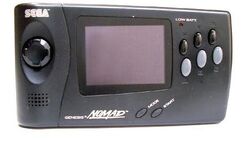This article is a stub. You can help Codex Gamicus by expanding it. |
| Genesis Nomad | |
|---|---|

| |
| Basic Information | |
Type(s) |
Handheld Console |
Generation |
Fifth |
| SEGA | |
| October 1995 | |
| Awards | Covers | Credits | Gallery | Help Patches | Reviews | Screenshots | Videos | |
The Genesis Nomad was a handheld video game console developed by SEGA, sold in North America and Japan, which was capable of playing Genesis video game cartridges. It was based on the Japanese Mega Jet and featured a built-in colour screen. The Genesis Nomad was never officially released in PAL territories such as Europe and Australia. Its codename during development was Project Venus, as per SEGA's policy at the time of codenaming their systems after the planets of the solar system.
Release and Features[ | ]
SEGA released the Genesis Nomad in October 1995 for $180. Marketed as a portable Genesis, the Genesis Nomad was primarily an evolution of the Japanese-marketed Mega Jet. Whereas the Mega Jet was screenless and required an AC adapter, the Nomad featured a 3.25" colour LCD screen and room for six AA batteries, making it completely portable as opposed to simply being a smaller Genesis console. In addition to its other improvements over the Mega Jet, an A/V Out plug was added at the top of the unit, letting owners play games on a television screen with a separate A/V cable. One particularly interesting feature of the Nomad was its ability to allow one player to play using a connected TV, while another watched on the Nomad. The directional pad on the unit controlled all one-player games, and a port on the bottom allowed a second pad to be plugged in for two-player games. This meant that the Nomad could be a fully functional home system as well as a completely portable hand-held solution with a pre-existing library of games available for it.
Issues[ | ]
While the Genesis Nomad won praise for its screen resolution and features, there were some problems. Neither the 32X and SEGA CD/Mega CD, nor the company's Power Base Converter which was used to play Master System games on the Genesis and Mega Drive, were intended to be compatible with the Genesis Nomad. While they did work for the most technically inclined of customers, forcing the matter involved modifying the add-on units' shapes or using bulky and sometimes dangerous 3rd party expanders. The Genesis Nomad had impressive technical specifications for the time including a full colour, backlit display, and supported an estimated 600 titles already on the shelves, in addition to being a functional home system.
However, the Genesis Nomad was bulky, and it offered very limited battery life in comparison to contemporary handhelds. It consumed much more power - nearly twice the amount - than the Game Gear.
Six alkaline AA batteries offered only about 2 hours (depending on volume and screen brightness settings) of play time, making batteries a significant expense for use on the go. A rechargeable battery pack was offered separately for $79. It offered even less play time and was not widely available. Rechargeable AA batteries were not recommended due to voltage problems (Ni-Cd provided 1.2V instead of the 1.5V that alkaline batteries output, and also required full discharging before recharging; Ni-MH AA batteries were not available at the time).
Despite a $100 price drop, the handheld did not garner enough support to continue. By the time it was released, the Genesis was almost at the end of its lifespan — already being replaced by the Saturn, PlayStation and Nintendo 64, and general indifference towards 16-bit era titles hastened its demise.
